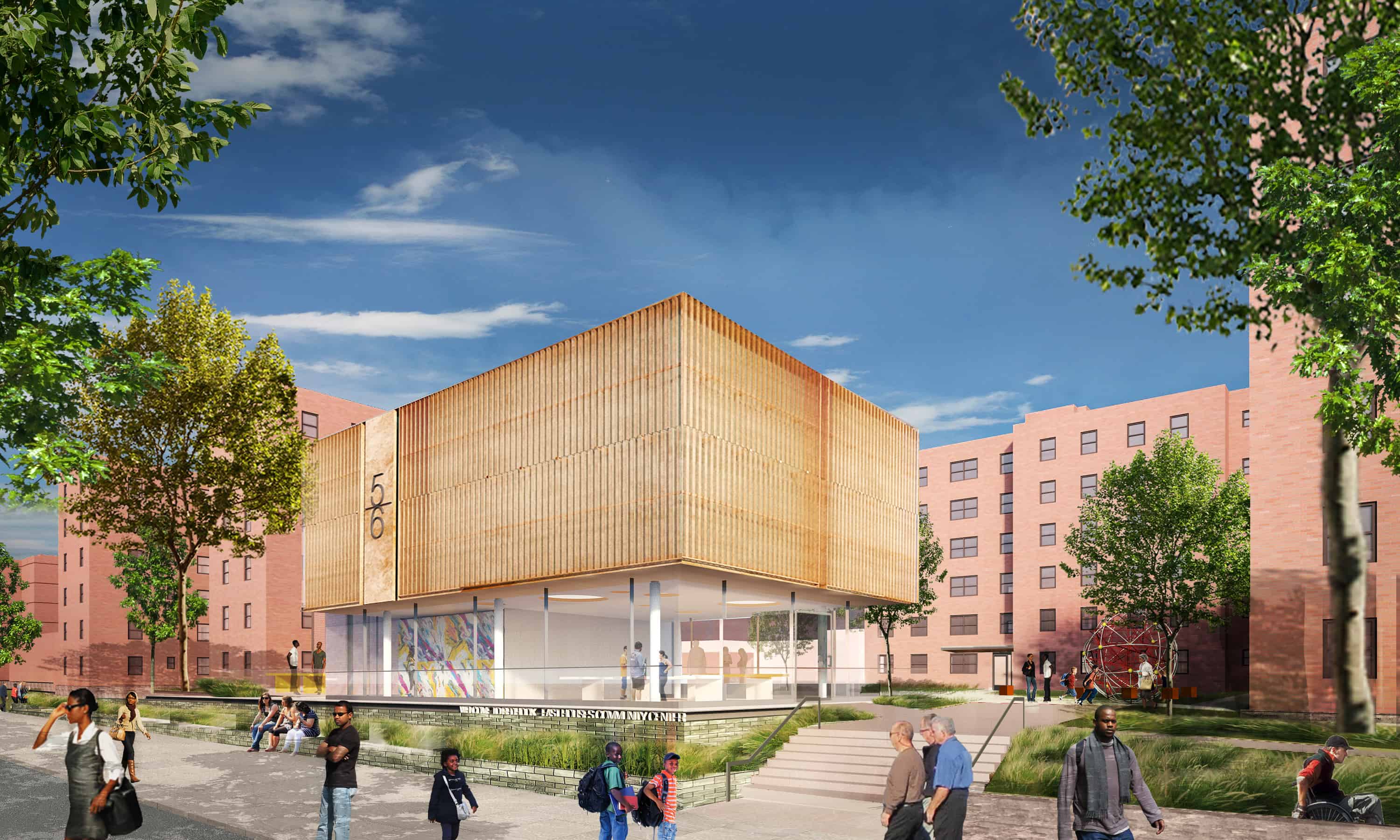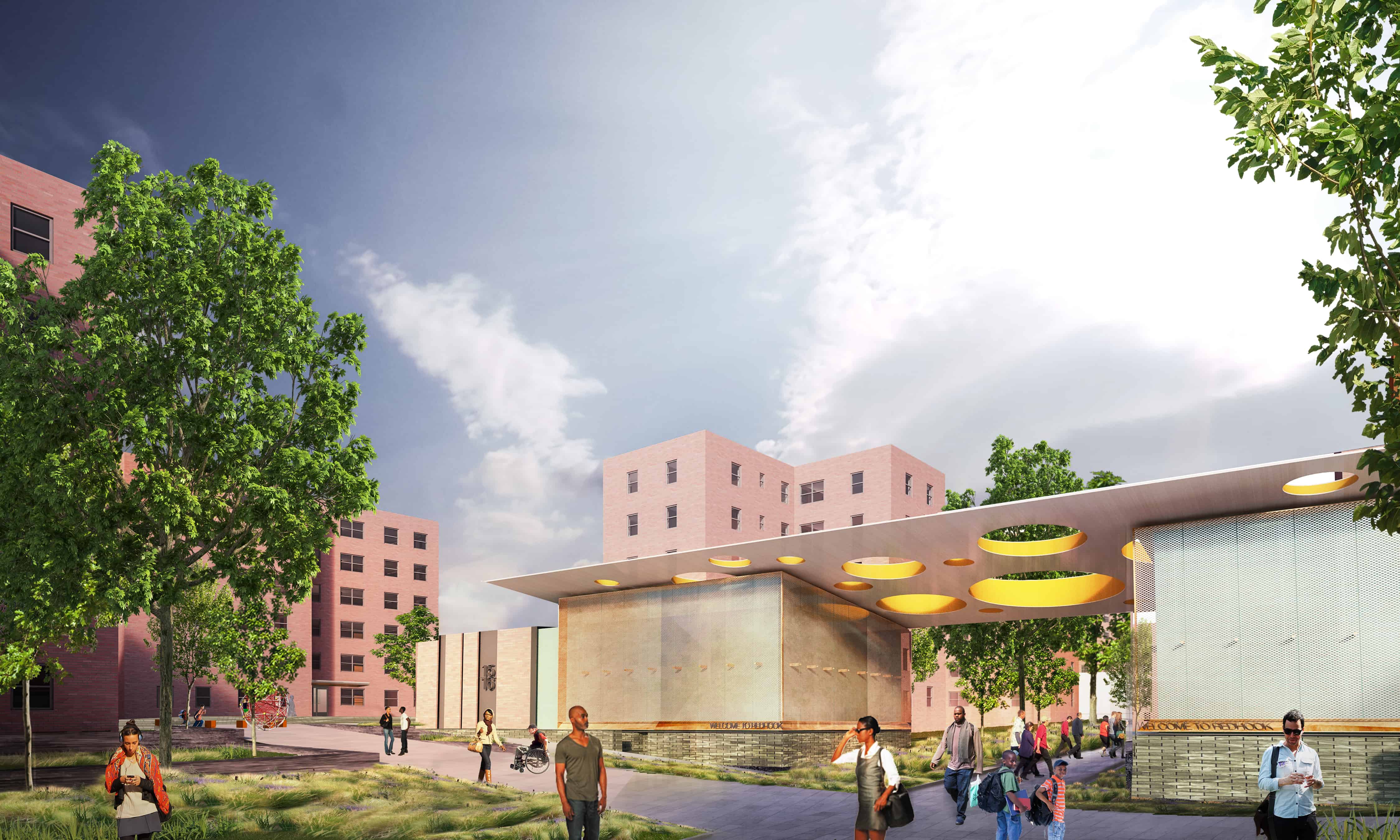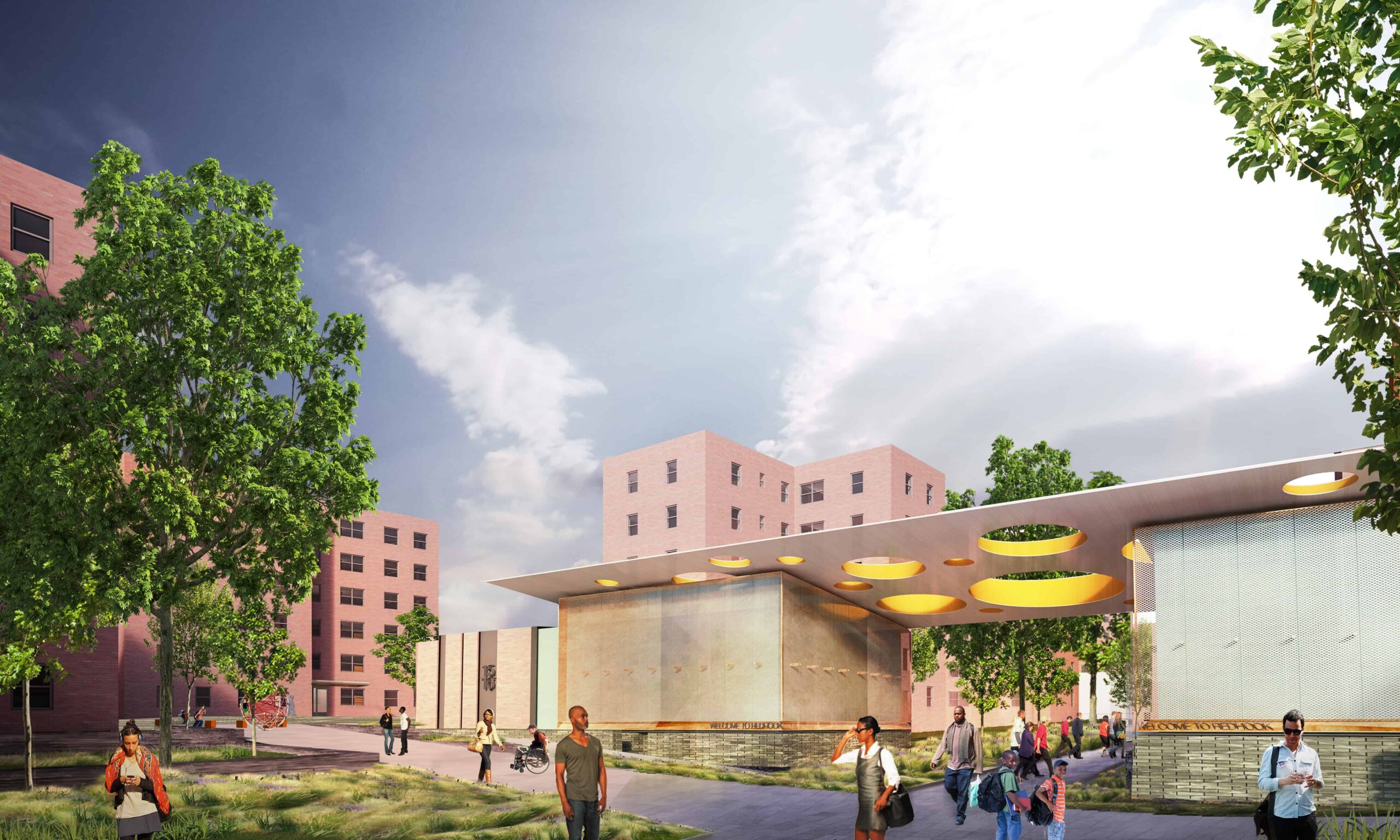
Hurricane Sandy badly affected the Red Hook Houses, worsening the already uncomfortable living conditions for Red Hook’s 6,217 New York City Housing Authority (NYCHA) residents. Sandy and its associated floods destroyed boilers, damaged roofs beyond repair, and compromised playgrounds, lighting, underground conduits, fencing, and sidewalks.
Four years after the storm, a process is underway not only to repair the damage, but to improve Red Hook’s NYCHA development overall. NYCHA has received $3.2 billion from the federal government, mostly the Federal Emergency Management Agency, to repair the damage from Hurricane Sandy. Of this money, almost $440 million will be used for Red Hook Houses East and West.
The architects working on the design for the recovery effort are Kohn Pedersen Fox Associates (KPF), a Manhattan-based firm that has worked on projects ranging from New York’s Museum of Modern Art to the World Bank Headquarters in Washington DC to the Lotte World Tower in Seoul, South Korea.
“Everybody here is very excited about the project,” says Jill Lerner, KPF’s principal for the Red Hook Houses design. “Everybody. We really take pride in developing some of the most vibrant urban centers around the world, and so why shouldn’t we do that in our own backyard for an area that really needs it?”
The Real Challenge
Hurricane Sandy hit NYCHA developments in every borough except Staten Island.
“The storm’s surge impacted 10 percent of NYCHA’s developments, knocking out power to more than 400 buildings and leaving 386 buildings without heat and hot water,” according to the NYCHA website. “With FEMA funding agreements in place and finalized in Fall 2015, extensive repairs to more than 30 developments can move from planning and design to construction and completion.”
A few years after the storm, KPF undertook a large research study on the many different aspects of NYCHA’s building portfolio.
“Our firm has been very interested in the challenges facing the NYCHA campuses,” says Jill Lerner “so we did some research that informed their Next Gen NYCHA program, and became familiar with the Urban design opportunities, and with NYCHA and the NYCHA portfolio.”
When the FEMA grant was approved, KPF considered submitting proposals for three of the Sandy-impacted NYCHA sites.
“We decided that Red Hook was where we felt we could make the biggest contribution,” says Lerner. “Red Hook’s a really interesting changing community. The Houses have a very interesting footprint architecturally, two parts that were built in different times, and the campus has architectural integrity. In addition it has a beautiful tree canopy, and it has a lot of landscape potential. We felt this would be something that we could really build on, leveraging the FEMA dollars to make a better and more resilient community.”
Devin Ratliff is KPF’s project manager for the Red Hook Houses. Ratliff, a Brooklyn resident, joined KPF in 1999, and as project manager works with the designers and NYCHA to “make sure we’re ticking all the boxes” on the programmatic and technical portions of the project. One aspect of the Red Hook project that appeals to him is the opportunity to help Red Hook’s public housing projects keep pace with the rest of the neighborhood.
“I think one of the really interesting thing about this project is to have NYCHA be part of that development of the neighborhood from a social and an economic point of view so it’s not just the main streets [such as Van Brunt Street] that are developing,” says Ratliff. “The FEMA funding helps NYCHA join that trend rather than being this unfunded animal that misses out.”
One critical aspect of working with NYCHA means engaging residents to share information and get feedback. But getting residents to meetings has always been a challenge for NYCHA.
“We need some clarity, some transparency,” says Wally Bazemore, a long-time Red Hook Houses resident. Tenants are “completely out of the loop, they don’t know what these guys walking around with these white helmets and reflectors are doing.”
Bazemore says that while NYCHA could do more to reach out to residents in advance of meetings, such as publicizing events online and at local non-profits, much of the responsibility for poor attendance is that of tenants themselves.
“I think they’re more concerned about the day-to-day things they have to do to get by, I guess they feel like they’re powerless, they can’t do any damn thing anyway,” says Bazemore. “When you have a community where only 12% vote, what do you expect?”
Yet despite the limitations of outreach, Ratliff feels that KPF’s design has gained a lot from tenant feedback.
“We’ve been to a bunch of community meetings, I think three or four over the course of the design phase of the project,” he says. “And we’ve tried really hard to listen to the things that people care about, and engage the community with the process rather than just impose it.”
KPF has altered several aspects of their design from neighborhood feedback. An early design would have necessitated moving the community garden – that changed based on community feedback. Plans to relocate the senior center were also canceled due to community concerns about inconvenience.
“A lot of the planning certainly had a lot of community input,” says Ratliff. “We don’t want anyone to be surprised.”
Leveraging the FEMA Funding
 FEMA is not paying for many of the improvements residents have been clamoring for for years, such as mold abatement or fixing the elevators and plumbing. The scope of KPF’s project is limited to Sandy-related repairs and preparing for future storms. But the architects do have some ambitious plans they hope will increase tenants’ quality of everyday life.
FEMA is not paying for many of the improvements residents have been clamoring for for years, such as mold abatement or fixing the elevators and plumbing. The scope of KPF’s project is limited to Sandy-related repairs and preparing for future storms. But the architects do have some ambitious plans they hope will increase tenants’ quality of everyday life.
“I think there continues to be some frustration in the community that we can’t get inside and renovate the apartments, but FEMA doesn’t fund it,” says Ratliff, who has attended all of KPF’s community meetings. “So one of the things that we really made a strong effort to do was to make sure that everything funded by FEMA that is part of the project benefits the residents of NYCHA on a day-to-day basis.”
The two most significant components of KPF’s design are the two district power plants, which will provide steam for the Houses and power during an outage, and the “lily pads,” which will elevate the areas between buildings above flood level and demarcate community space.
“I think the lily pads were really a eureka moment,” says Ratliff. “Right now you have these buildings that are sort of dropped onto the site and a forest of ramps and stairs that lead up to the entries.”
He noted that, like a lot of public housing projects, the existing design creates a sense of isolation, or “no man’s land,” at the buildings’ entrances.
“There’s all of this infrastructure to move you from the ground up to the entrance, but no real place to gather. There’s no front stoop as there is on a brownstone block, there’s no courtyard. There aren’t really benches, and there’s no threshold that defines when you move from the center mall, the primary walking path that cuts across the site, into the realm of the front court of the building,” continues Ratliff. “And without that line, the space tends to feel like it bleeds out.”
In addition, KPF is trying to keep water out of the lobbies, improve accessibility for handicapped and aging residents, rebuild the playgrounds, and replant trees dying from salt infiltration. They think the lily pads will help with all of these problems.
“We’re taking the entire landscape between two buildings and raising it up,” says Ratliff. “We think that that could lead to a really great social space for those residents, and they could become a smaller unit of a larger community.”
Red Hook Houses East and West will each have a dedicated boiler plant, as well as a network of utility pods to distribute steam and electric to each building. All will be above flood level.
One boiler plant will be on the southern border of Coffey Park, currently a parking lot. The plant will be a sloped structure with plants growing along the top and a sheltered space for pedestrians underneath. KPF hopes that, in addition to housing a boiler and electrical plant, the structure will serve as a gateway to the park.
The other plant, which will be located at the intersection of Ninth and Clinton Streets, will house retail commercial space on the bottom floor.
Will the boilers be noisy? Ratliff expects them to be better than the pre-storm boilers, and far better than the temporary boilers NYCHA has used since.
“What we’re designing meets all codes and environmental regulations,” he said. “Generally speaking we’ll have thick concrete walls around the boilers, and so we would expect them to be quieter, and less emittive, than what’s existing.”
The utility pods that distribute the power and steam generated by the plants will also perform double duty – several will be elevated enough that community space can be provided underneath. There will be one pod for every two buildings.
Ratliff thinks KPF is meeting the residents’ needs.
“It’s a really great opportunity to help restore NYCHA to part of its founding principles of providing great housing for the economically disadvantaged folks in the city.”
The Timeline
 KPF estimates that the design for the project will be completed within the first few months of 2017. Once the design is finalized, the bidding process and construction will probably take around three years.
KPF estimates that the design for the project will be completed within the first few months of 2017. Once the design is finalized, the bidding process and construction will probably take around three years.
“NYCHA expects to complete design by the end of 2016, and anticipates starting major construction in Spring 2017,” writes NYCHA spokesperson Zodet Negron. “NYCHA has already begun some preliminary construction with demolition of damaged boilers, renovation of first floor apartments damaged by the storm, replacement of electrical conduits, as well as the reconstruction of the Red Hook Senior Center.”
During the procurement and construction phases, the process will be overseen by the construction manager, the LiRo Group.
“The construction manager attends our [community] meetings, they follow along, they respond,” says Ratliff. Once construction starts, “they’re the ones that are having a direct impact on the residents. So there is a shift in who takes the lead. If people are complaining about noise, the construction manager can actually address the problem.”
Many residents do have concerns about the impact construction may have on their quality of life. Wally Bazemore, for instance, is worried about the health effects of construction.
“It all depends on what type of construction they’re going to be doing and what kind of chemicals they’re going to be using,” says Bazemore. “This is a community where respiratory diseases run rampant. Children have asthma. So [it will be a problem] if some of the construction is not controlled and some of the residents are not warned that they’ve got to keep their windows closed between this hour and that hour because some of the residue that might float in their apartment.”
Besides the effects of dust and chemicals, Bazemore is concerned about the safety of children living in the NYCHA development.
“The kids are out here playing, they play in the grass sometimes,” says Bazemore. “There has to be a safe zone while they’re doing some of this construction. I haven’t heard the plan on that yet.”
That’s partially because there is no plan on that yet.
“This is such a big site, we have yet to see any drawings from construction manager as to how he plans to implement the work logistically, which areas he’s going to work on first, things like that, and that’s critical.” says Lerner. “I think NYCHA would be well-served to have regular meetings throughout construction to keep people abreast of what’s going on.”
Lerner says that while the health impact should be minimized by use of low-hazard materials and techniques which meet high environmental standards, “construction is inherently a noisy, dusty, disruptive process with a lot of vibration at certain times.”
Lerner hopes that LiRo will proactively seek residents’ feedback in the same way KDF has.
“This is a vocal community and I hope we will work together for the best experience possible,” says Lerner
NYCHA to Offer Pre-Apprenticeship Training for Residents
Red Hook’s NYCHA residents have repeatedly called for hiring local tenants as part of any recovery effort. The Housing Authority recently released a Request for Proposals (RFP), due October 13, to provide pre-apprenticeship training for NYCHA residents in Sandy-affected areas.
“Pre-apprenticeship programs teach basic construction safety and the skills necessary to become an apprentice in a union,” says NYCHA’s September 7 press release. “Graduates from these programs receive help getting placed into a union apprenticeship, which provides them with a pathway to union construction jobs. NYCHA expects to recruit and place up to 100 residents in Sandy construction jobs through the selected pre-apprenticeship programs.”
The pre-apprenticeship training program (P-ATP) will be funded through a $317 million grant from the federal department of Housing and Urban Development (HUD). Since HUD requires its grantees to employ public housing residents and other low-income persons wherever possible, NYCHA will be using $1.4 million of this grant for the P-ATP.
The rest of the the money will be used as a required local match for the FEMA money.
While the P-ATP slots will not necessarily go to Red Hook’s NYCHA tenants, the program is directed toward Sandy-affected communities. According to NYCHA spokesperson Zodet Negron, the program provider must have a good track record of placing its P-ATP graduates into a union.
“Once a resident is in the union they will have access to work on construction projects throughout New York City,” writes Negron. “NYCHA has built relationships with the unions so that if residents want to work on NYCHA Sandy contracts they will have the ability to and will be given preference.”
NYCHA does not yet have estimates of how many NYCHA residents will become employed through the P-ATP, as contractors only supply hiring plans once they are engaged.
“As new contracts are signed, contractors provide NYCHA with a hiring plan that shows how many new jobs are expected to be created, and how they plan to engage NYCHA residents,” writes Negron.
NYCHA’s goal is for 30% of new hires for the Sandy recovery efforts to be residents.
“Construction is hard work, but it’s a great opportunity for anyone willing to work hard,” NYCHA resident and Local 79 member Jesus Lopez says in NYCHA’s RFP press release. “This is a ticket to get into any kind of union you want to get into; this is an opportunity that could open doors that could change your life.”
Questions and answers at a glance
When will construction be complete?
Between 36 and 40 months from now.
(source: NYCHA)
Will anyone have to move?
Yes – as things currently stand, residents on the upper floors of the building at Ninth and Clinton Streets will be located to other apartments in the Red Hook NYCHA campus. Contrary to rumors, however, no ground floor residents will be relocated. KPF was considering moving residents in order to widen the lobbies as well as due to flood level concerns, but neither was found necessary.
(source: KPF)
Will any jobs be created?
NYCHA hopes that NYCHA residents will make up 30% of new hires for the construction. NYCHA has released an RFP to provide pre-apprenticeship training for up to 100 NYCHA residents from Sandy-impacted housing developments.
(source: NYCHA)
Where is the money coming from?
The bulk of the $3.2 billion NYCHA is using for Sandy recovery is from FEMA. A relatively small amount ($317 million) is from HUD in the form of a Community Development Block Grant for Disaster Recovery (CDBG-DR).
(source: NYCHA)
How much will be spent on Red Hook Houses East and West?
$197,483,254 for East and $240,730,390 for West.
(source: NYCHA)
What is the scope of the project?
Sandy-related repairs to buildings and grounds. NYCHA’s list follows.
BUILDING(S)
• Abate & restore building crawl spaces
• CCTV & Layered Access Systems(LAC)
• Contents damaged as a result of Sandy (i.e. equipment and supplies)
• Dry flood proofing above design flood elevation to protect building envelope in flood prone areas
• Full roof replacement
• Installation of stairwell lighting
• Repair and restore architectural features (walls, floors) of common areas damaged by flooding. Replace doors, frame & hardware damaged by flooding
GROUNDS
• Remove underground fuel oil storage tank(s) as required.
• Replacement of underground conduits & site lighting
• Restoration of play ground surface areas and play structures damaged by Sandy
• Site Restoration (sidewalks, asphalt resurfacing, fencing etc) of Sandy damaged areas as well as any areas that may be affected by construction
MECHANICAL, ELECTRICAL AND PLUMBING
• Installation of stand-by generators to provide full back-up power
• New building to house boiler equipment above the Design Flood Elevation(DFE)
• New electrical annexes to be located above the Design Flood Elevation (DFE) to house new C/T cabinets
• Restoration of Sandy damaged portions of mechanical, electrical & plumbing systems
(source: NYCHA)









